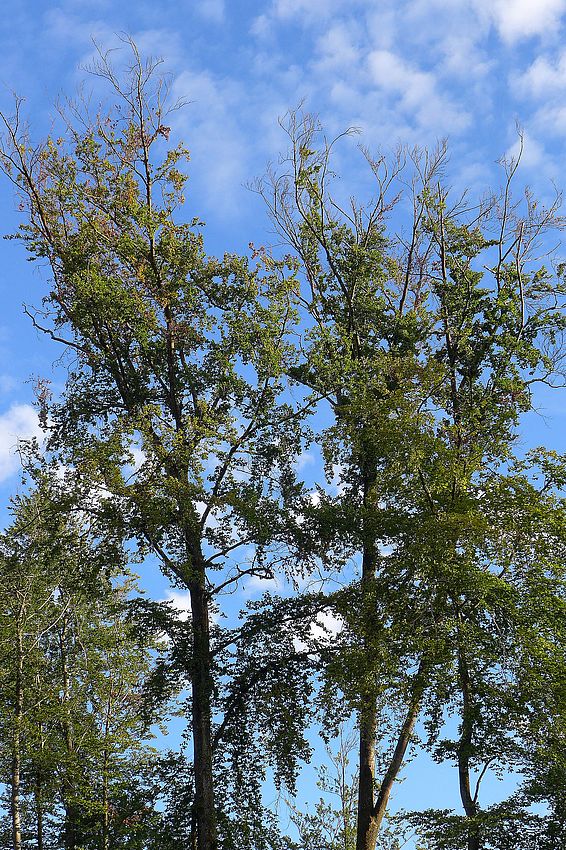16.12.2020 | Reinhard Lässig | News WSL
How do Swiss beeches respond to extreme drought? To answer this question, researchers at the Swiss Federal Institute for Forest, Snow and Landscape Research (WSL) studied 75 National Forest Inventory (NFI) sample plots during and after the dry summer of 2018. Reduced growth and an abundance of prematurely discoloured leaves and thinned crowns provided clear evidence of a loss of vitality in many of the beeches examined. However, most of the trees recovered the following year, when the weather was wetter and less hot.
From late spring 2018, almost all parts of Switzerland experienced a prolonged period without rainfall. This was followed by above-average summer temperatures, which led to extreme drought across much of Central Europe. In many places on the Swiss Plateau and in the Jura, the leaves of deciduous trees aged prematurely. As early as mid-July, many beeches displayed small, brown and slightly shrivelled leaves that remained attached to their branches.
Lucky timing: sample plots surveyed prior to drought
Prior to this drought, field work had begun for the fifth NFI being carried out by WSL in cooperation with the Federal Office for the Environment (FOEN). By the end of May, WSL's NFI survey teams had already taken measurements at 75 sample plots in beech forests in German-speaking and French-speaking Switzerland. As part of the WSL Drought Initiative 2018, the researchers took the opportunity to visit these NFI plots again in late summer 2018 and then in 2019 to find out how the 271 beech trees growing there had responded to the drought.
Clear diagnosis based on three symptoms
In late summer 2018 and 2019, the researchers assessed how the vitality of the beeches developed during and after the extreme drought, based on their crown transparency, leaf discolouration and stem diameter growth. The team of researchers from WSL and ETH Zurich recently published the study findings in the journal Ecological Indicators.
The measurements in late summer 2018 revealed that beeches with brown, discoloured leaves and unusually transparent crowns were much more frequent than the average from long-term observations. The main possible causes were deemed to be reduced growth in previous years, strong competition from neighbouring trees and the local precipitation deficit. The researchers also found that larger trees tended to be more severely affected than smaller ones.
Wood growth in 2018 was significantly lower than the average for 2010–17 across all 75 plots. Moreover, beeches with both prematurely brown leaves and transparent crowns did significantly worse, in terms of growth, than trees that retained a more vital appearance.
2019: a year of recovery
Thanks to favourable weather, the condition of many of the beeches examined improved in 2019. Strong foliage discolouration was only observed in one tree, and crown transparency was roughly in line with the long-term observations. Growth in 2019 was significantly greater than in 2018, and even exceeded the average for 2010–17.
This study, carried out at short notice, illustrates beeches' rapid response to the dry summer of 2018, which manifested itself in premature browning of leaves, above-average crown transparency and, ultimately, a low level of growth in the examined trees. However, in the majority of beeches studied, these effects of hot weather and low precipitation were – for the time being, at least – only temporary.
Importance of long-term forest monitoring
If climate change causes further alteration in precipitation and summer temperatures, this is likely to affect the health, functioning and growth of forests. Moreover, forests that produce less wood than normal due to severe drought will also sequester less carbon.
This study was only possible because there has been a permanent network of over 6,000 NFI sample plots in Swiss forests for more than 35 years. This not only avoided a time-consuming and painstaking search for suitable sites but also provided robust, long-term measurements against which to compare the data from 2018 and 2019. Such permanent measuring networks could also prove useful in the future for investigating environmental or ecological interrelationships and quantifying the impact of disturbances.
Contact ¶
Links ¶
Rohner, B.; Kumar, S.; Liechti, K.; Gessler, A.; Ferretti, M., 2021: Tree vitality indicators revealed a rapid response of beech forests to the 2018 drought. Ecological Indicators, 120: 106903 (10 pp.). doi: 10.1016/j.ecolind.2020.106903
Rapid survey on short-term effects of 2018 drought on beech forests in Switzerland
Copyright ¶
WSL and SLF provide the artwork for imaging of press articles relating to this media release for free. Transferring and saving the images in image databases and saving of images by third parties is not allowed.



